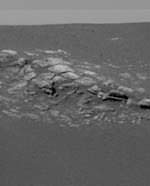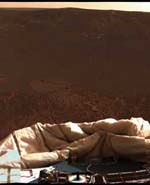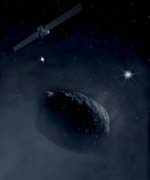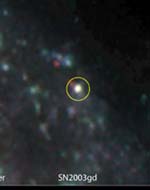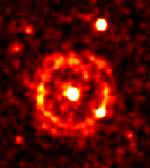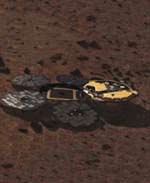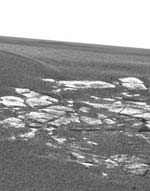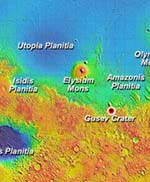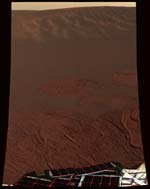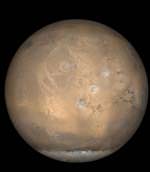
Image credit: NASA
On January 14, President George Bush gave a speech at NASA headquarters outlining a new strategic orientation for the American space agency. While some of the initial ideas for implementing the new space policy can and should be substantially improved upon, the policy overall clearly represents a significant and long-overdue step in the right direction for the American space program. The Steering Committee of the Mars Society therefore welcomes the new policy as presented in Presidential Directive entitled ?A Renewed Spirit of Discovery,? and strongly urges Congress to provide the funds requested for the initial steps requested for the program over the next fiscal year.
Our analysis of the important strengths and required areas for improvement of the new policy is presented below.
Analysis
As stated, the new Bush space policy offers both opportunities and pitfalls to those interested in furthering human exploration and expansion into space in general, and Mars in particular. While not representing the start of an actual Moon/Mars program, since nearly all serious spending for hardware systems other than the crew capsule is deferred to administrations coming into office in 2009 or beyond, it does in fact clear the ground for the initiation of such a program should the 2009 administration be so inclined. It also provides a certain amount of free energy that, if handled properly in the 2004-2008 period, could be used to help insure the emergence of a powerful human exploration initiative within the time frame of the 2009 administration.
In his speech, Bush redefined the purpose of the American space program as the ?establishment of a human presence throughout the solar system.? This statement may seem to some like a mere rhetorical flourish, but it actually has important concrete programmatic significance, as it legitimizes NASA spending supporting technology development for human exploration of the Moon and Mars. Such spending was forbidden under the previous order of things, and for the past ten years technologists seeking funding for important human Moon/Mars exploration technologies had to justify them by arguing their value for other established programs, such as the JPL-led robotic exploration program or the ISS. This has made it impossible to obtain adequate funding for many technologies, such as planetary in-situ resource utilization (ISRU), and has led to disasters such as the promising JSC-led Transhab inflatable habitation program, which was derailed when the discovery that planetary exploration technology work was being done under ISS cover led to cancellation by congressional staff. It is for this reason that the Mars Society has had since its Founding Convention in 1998 campaigned for the establishment of a NASA line item for the support of human exploration technology development, so that such activity could take place openly. Bush?s initiative fully accomplishes this objective, with healthy initial program funding. For this reason, if no other, Bush?s move must be seen as an extremely positive development.
The new policy will also create a program organization at NASA headquarters, called Code T, which will significantly raise the level of NASA efforts to develop efficient plans for human planetary exploration. This is also a welcome development.
In addition, the Bush policy also provides a basis for including human exploration research requirements within the design of robotic planetary missions. In the late nineties, representatives of the human exploration missions office at JSC attempted to utilize flight opportunities aboard the JPL-led robotic Mars exploration landers, but as the JSC researchers had neither a mandate nor money, they had neither force nor funds to back up their requests, and were dealt with accordingly. Under the new space policy, both a mandate and funds should be available to support human exploration related research and technology flight experiments aboard robotic lunar and planetary spacecraft. This could allow such payloads to either fly as paying customers aboard the JPL/Code S sponsored science spacecraft, or alternatively, support the funding of human exploration program-controlled robotic landers whose primary mission would be to provide engineering data for the human exploration program, with other science payloads carried on a space-available basis.
The Bush policy also identifies where the funds required to support a true human exploration initiative will come from, to wit the redirection of the existing Space Shuttle and ISS budgets. Currently, the Shuttle budget runs about $4 billion per year, while the ISS budget is between one and two billion. This total of $5-$6 billion per year is more than sufficient to get humans to both the Moon and Mars within ten years of actual program start. Thus the initiative can be done within the existing NASA budget of about $16 billion per year in 2004 dollars, a level found supportable by presidents and congressional majorities of both political parties for the past four presidential terms. Thus the financial basis for the program is clear, and is not a budget buster or in any way fantastical.
In his speech, the President invited all nations to join with the United States in pursuing the proposed program. We welcome this statement, as we fully agree that the exploration and settlement of the solar system is a great goal that can help bring humanity together, one that is worthy of, and requires, the mobilization of the best talents of all the peoples of the Earth.
For various political and diplomatic reasons, the Bush policy delays the phase out of the Shuttle and ISS until 2010, thereby delaying substantial human exploration program start until about that time. Thus the choice on whether or not to really start a Moon or Mars human exploration program, and what its pace or objectives should be, is effectively being placed in the hands of the 2009 administration.
The merit of this decision is debatable. A key point however, is that the 2009 administration will have a choice. By making clear that the fundamental purpose of the human spaceflight program is to allow humans to FLY ACROSS SPACE (the Apollo era vision) to explore other worlds, rather than to allow humans to EXPERIENCE SPACE (the Shuttle era vision), the Bush policy (should it be sustained by either his reelection or the concurrence on this issue of an alternative 2005 administration) effectively precludes the commitment of NASA to a second generation Shuttle (?Shuttle 2?) as its next major program. As recently as a few months ago, substantial factions within space policy circles in both congress and NASA projected such a Shuttle 2 program as the agency?s next major project after ISS. Had that occurred the future would have looked like this: the present decade would be consumed with returning the Shuttle to flight and building ISS. The next decade would be devoted to extending the life of Shuttle and developing Shuttle 2. The 2020?s would then be a repeat of the 1980?s, attempting to make Shuttle 2 operational, leading to a decision in 2030 on the next major project, which probably would have been ISS-2. Thankfully, this ?Groundhog Day? scenario for perpetual stagnation in space has now been foreclosed on.
The decision to punt the responsibility for implementation, and thus the control, of the program to the 2009 administration promises to make the next five years an extremely interesting time for space advocates. In his speech, Mr. Bush defined human expansion into the solar system as NASA?s goal, and posed the idea of a lunar base initiated by 2020 as the strategy by which this objective might be approached. That is one plan, but the next five years will see other plans put forward for consideration by the political class as efficient means by which the desired overall goal can be achieved with maximum speed, reliability, and at minimum cost. The great debate on what our strategy for reaching the Moon and the planets should be has thus not been closed by Bush?s speech, but opened.
The victory in this healthy battle of ideas will go to those people who convince the players, not merely of today, but of 2009 and beyond, of the merit of their concepts. The Mars Society welcomes this challenge, and will seek to actively participate in this discussion to contribute its technical expertise and to convey an understanding to the political class, the technical community, the press, and the public that within the context of the new space policy, that the near-term human exploration of Mars is feasible, affordable, and truly worthy of the efforts and risks required.
In transitioning from one kind of space program to another, every effort should be made to prevent unnecessary collateral damage to valuable parts of the old program. The decision announced by NASA headquarters late last week to abandon the planned Shuttle mission to upgrade and reboost the Hubble Space Telescope (HST) is an example of the kind of mistake that needs to be avoided. The Cosmic Origins Spectrograph and Widefield Camera 3 designed to bring the HST to its full potential have already been built and tested, and promise an enormous scientific return upon delivery to orbit. If the Bush plan were to stand down the Shuttle immediately, and save the $24 billion required to operate it through 2010 so as to initiate the Moon/Mars program with substantial funding immediately, that would be one thing. But given the decision to return the Shuttle to flight, canceling the Hubble upgrade would only save about $200 million, or 1% of the Shuttle program?s budget, while destroying about 90% of its scientific value. This is extremely foolish.
Safety arguments won?t wash either; if the Shuttle is safe enough to fly to the ISS, its safe enough to perform its mission to Hubble. Indeed, while Shuttle missions to the Hubble may lack the on-orbit safe-haven of the ISS, the low-inclination of Hubble flights enables launch aborts to warm tropical waters, where crew survival chances are much better than in the frigid north Atlantic abort sites required by ISS launches. Moreover, it is difficult to understand how an agency which is too risk adverse to undertake a Shuttle mission to Hubble could possibly be serious in considering a mission to the Moon or Mars.
The cancellation of the Hubble mission can thus only be described as a serious mistake, apparently committed in the name of the desire to appear ?decisive? in breaking from the old paradigm in favor of the new. In addition to the harm done to astronomy, it would be a very bad thing for the infant new space policy to begin its life with a such a distasteful record. Under no circumstances should the alleged impending availability of the James Webb Space Telescope be accepted as a rationale for abandoning Hubble, either. That would be to repeat the mistake NASA made in abandoning the Saturn V for the supposedly superior Shuttle, or Skylab for the ISS ? errors which set back the space program by decades of time of tens of billions of dollars. If NASA?s leadership will not see reason on this issue, Congress should take forceful action to reverse this very bad decision.
Technological Issues
The right way to do a program whose objectives encompass both a permanent lunar base and the human exploration of Mars is to design a set of transportation hardware that can accomplish human Mars missions, a modified modular subset of which can be used to support lunar activities. Approaching the problem in this way can save a great deal of time and money, as only one hardware set needs to be developed instead of two. It also maximizes the value of the Moon as a testing ground for Mars, since under this approach to Moon missions will be done using the Mars hardware, and serve directly to shake it out. Provided this is the approach adopted, a program initiated in 2009 could easily achieve piloted lunar landing by 2015 and launch the first human Mars expedition by 2018. The build up of a permanent lunar base and continued Mars missions could then occur simultaneously. Since it is only possible to launch to Mars every other year in any case, the implications of a running concurrent programs are simply that the lunar program launch rate would be reduced somewhat during Mars launch years. Concurrent launch programs would also serve to minimize launch costs by maximizing the rate of production of the booster production lines, as the cost of running a launch vehicle manufacturing facility increases only marginally with a higher production rate. To use a mundane analogy, it takes very little extra labor to cook two steaks instead of one, provided you cook them both at the same time. In the production of launch vehicles this kitchen parable holds even more force, as labor costs overwhelmingly dominate those of materials.
Within the context of such a well-planned Moon/Mars program, there are certain technologies that are essential. We address only two of the most critical, heavy lift boosters and ISRU.
Heavy Lift Boosters
The key technical instrumentality required to make lunar bases and Mars missions feasible is a heavy lift vehicle with a hydrogen/oxygen upper stage capable of throwing payloads in the 50-tonne class on Trans-lunar or Trans-Mars injection. This is the capability demonstrated during the 1960?s by the Saturn V. Once such a vehicle is available, roundtrip Lunar missions or one-way delivery of habitations and other heavy payloads to the lunar surface can be readily accomplished with a single launch. Piloted Mars missions can also be accomplished using multiple discrete Trans-Mars launches of such a system, with no on-orbit assembly, as shown by the Mars Direct plan (Zubrin and Baker, 1990), the Stanford Mission plan (Lusignan, et al 1992), or the JSC Design Reference Mission 3 (Weaver et al, 1994).
Such Saturn V class launch systems can be readily created at this point either by converting the Shuttle launch stack through elimination of the orbiter and its replacement with a LOx/H2 upper stage, or the creation of new, all-liquid propulsion booster systems. The Mars Society was recently shown plans by one major aerospace company for evolving its existing line of medium lift boosters to create a family of modular heavy lift boosters with payloads ranging through quarter, half, and full Saturn V capabilities. Based on this company?s experience with previous successful launch vehicle developments, the entire development program to create the whole family of boosters could be accomplished in five years with a development cost of about $4 billion. The recurring launch cost for the Saturn V class system design was $300 million per launch, or less than $1000/lb for payload delivery to LEO. The methods of creating such booster families are obvious to experienced launch vehicle engineers, and we have no doubt that this company?s competitors have plans for creating similar hardware sets with comparable development costs and schedules.
The claims by certain pundits opposed to any exploration initiative that a new heavy lift booster would cost tens of billions to develop can thus readily be shown to have no basis in fact. Such heavy lift vehicles would also have many applications outside of the human exploration program.
ISRU
Both lunar bases and Mars expeditions are strongly benefited through the use of in-situ resource utilization (ISRU) techniques for the production of return propellant, human consumables, and vehicle fuels and oxygen for use in extended missions on a planetary surface. The mission mass savings for either lunar bases or Mars missions resulting from ISRU has been demonstrated in numerous studies, and significantly exceeds that offered by advanced propulsion concepts with much higher development and recurring system costs.
Effective ISRU require both chemical processing systems and reliable sources of power, for which space nuclear systems offer the greatest promise. We therefore strongly commend the administration for its Prometheus project to create such space nuclear systems. However we note that up until now, the sole applications considered by NASA for its space nuclear power systems have been spacecraft power and nuclear electric propulsion (NEP). Without dismissing the important value of NEP for outer solar system robotic missions and other missions involving large velocity changes undertaken across extended time frames, we note that the size of NEP units required to supply propulsion for human exploration missions are on the order of 10,000 kilowatts. In contrast, when used to produce chemical propellants on planetary surfaces, the required reactor size to support human exploration is reduced to about 100 kilowatts. This is because a much smaller reactor stationed on a planetary surface making propellant can emit energy over a long period of time prior to flight, store it as chemical propellant, which then can release the energy as fast as it is needed under flight conditions. The mission mass leverages achieved by such ISRU supported chemical propulsion options are greater than those offered by NEP, while for inner solar system missions, the flight times are less (two orders of magnitude less for Lunar applications). In addition, the ISRU-supported chemical systems can be used not only for orbital transfer, but for planetary ascent.
Thus while space nuclear power is enabling for ISRU, it is ISRU that greatly reduces the cost, and increases the value of space nuclear power in supporting human exploration. The two technologies should thus be pursued in parallel, and an appropriate fraction of the Prometheus budget applied towards bringing ISRU applications of space nuclear power to flight status, and to support robotic missions demonstrating such technology on the Moon and Mars.
Furthermore, requirements should be written into the Prometheus program to insure that the power systems developed are compatible for operation on the surface of the Moon and Mars, since their use on the planetary surface to produce propellants and consumables represents by far the most advantageous method of employing them to support near-term human space exploration, and their power is needed on the surface to support base operations in any case.
Both ISRU technology and heavy lift booster development should thus be central priorities of the Code T effort over the immediate period.
Other systems should be developed with similar concern for maximum commonality of hardware and technology across lunar and Mars mission applications.
Political Implications
The train of events set in motion by the new space policy will create a decision point circa 2009 that will offer three alternatives for future action. These are;
1. The 2009 administration could choose to abort the Moon/Mars program altogether, and simply use the Crew Exploration Vehicle (CEV) as a capsule launched atop expendables as a way of continuing to visit the ISS. This would lead to a Mir-type extended ISS program, conducted at lower cost than possible using Shuttle launches, but with no discernable purpose. This would result in stagnation in space for however long such a programmatic decision prevailed, and probable retrogression on heavy lift, ISRU, and other programs necessary for human exploration.
2. The 2009 administration could decide to proceed in accordance with idea of building a lunar base, starting 2020, without concern for the Mars mission except to make claims that lunar experience will no doubt be useful later when others contemplate going to Mars. This would result in the development of mostly incompatible lunar program hardware (except the booster), making it necessary to start developing an entire new hardware set circa 2030, or possibly 2040, given the budgetary entanglements such a stand-alone lunar program would create, making it likely that the first Mars landing would not occur before the middle of the 21st Century. Alternatively, given the limited interest provided by repeated dead-end Lunar expeditions, the program could simply expire.
3. The 2009 administration could decide to launch a humans to Mars program, with the objective of reaching Mars within ten years, with expeditions to the Moon using a modified subset of the Mars flight hardware beginning around program year 7. Because only one hardware set would need to be developed instead of two, and because in aerospace cost equals people times time, this represents a much lower cost approach to achieving the goals set forth in the new space policy than alternative (b). Moreover, it is the only approach that will result in human explorers walking on Mars within the working lifetime of any adult today.
It is therefore imperative that everyone who wishes to see the human exploration of Mars become a reality do everything he or she can to fight for the bold course represented by option C. In the labs and engineering organizations, in the press, in the classroom and the committee room, in the Arctic and in the desert, in the halls of congress, and in every venue of public opinion ranging from books and technical papers to internet newsgroups and late night talk radio, each will need to play their part.
A door has been opened, and a battle of ideas that will determine the shape of the human future for many years to come has now been truly joined. Where it will lead is up to us. Contending visions that two weeks ago were mere hypothetical debates among space activists have now entered the center of political discourse. We welcome the challenge. For as reason is our witness and courage is our guide, we shall prevail.
Original Source: Mars Society News Release
